Chris Rywalt's Synergetics Photo Page
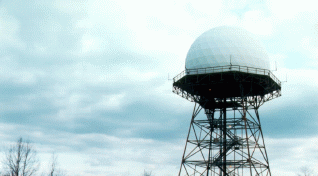 This is a picture of a dome near Philadelphia. It appears to be used
to house antennae and satellite dishes.
This is a picture of a dome near Philadelphia. It appears to be used
to house antennae and satellite dishes.
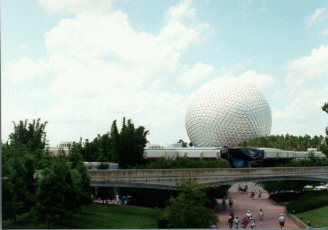 This is a picture of what is probably the most famous geodesic in the world,
namely the Geosphere at Walt Disney World, Florida. Disney's promotional
literature claims that this isn't a geodesic, because they say geodesics
are only partial spheres and this is a whole sphere. They're wrong:
being geodesic has nothing to do with how much of the sphere is present.
Actually, the name geodesic as applied to domes or spheres is something of a
misnomer, as modern geodesic designs only occasionally employ full great
circles.
In the next photo,
This is a picture of what is probably the most famous geodesic in the world,
namely the Geosphere at Walt Disney World, Florida. Disney's promotional
literature claims that this isn't a geodesic, because they say geodesics
are only partial spheres and this is a whole sphere. They're wrong:
being geodesic has nothing to do with how much of the sphere is present.
Actually, the name geodesic as applied to domes or spheres is something of a
misnomer, as modern geodesic designs only occasionally employ full great
circles.
In the next photo,
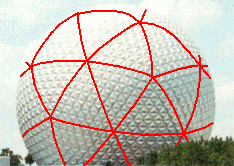 which has the exploded polyhedron faces
delineated, you can see that the Geosphere is what's called a Class II
(or triacon) breakdown by Hugh Kenner in Geodesic Math. It's
a 16-frequency sphere. (Thanks to
George Hart for pointing me back to Geodesic Math to figure this out.)
That is, rather than subdividing the triangular faces of an icosahedron, as
you would in a Class I, you subdivide the rhombic faces of a rhombic
triacontahedron -- a thirty-sided solid.
which has the exploded polyhedron faces
delineated, you can see that the Geosphere is what's called a Class II
(or triacon) breakdown by Hugh Kenner in Geodesic Math. It's
a 16-frequency sphere. (Thanks to
George Hart for pointing me back to Geodesic Math to figure this out.)
That is, rather than subdividing the triangular faces of an icosahedron, as
you would in a Class I, you subdivide the rhombic faces of a rhombic
triacontahedron -- a thirty-sided solid.
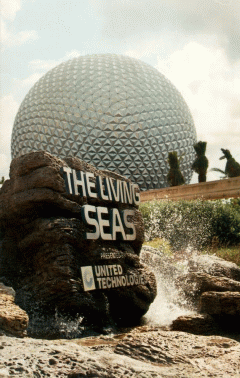 This is the Geosphere from another angle. (Looks
like a postcard, doesn't it? But it ain't -- I'm just a talented
photographer.)
This is the Geosphere from another angle. (Looks
like a postcard, doesn't it? But it ain't -- I'm just a talented
photographer.)
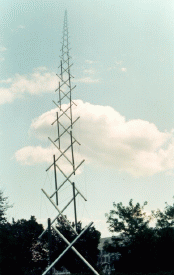 This is a sculpture outside of the Smithsonian Institute in Washington, D.C.
It's not attributed or titled as far as I could find, but Jay Kappraff in
his very good book Connections attributes it to
Kenneth Snelson (not
too much of a surprise) and calls it Needle Tower. (Kappraff's book
also has a photo of it which is almost identical to mine.) And Joe Moore
helpfully writes: `` `Needle Tower' was designed by Kenneth Snelson in 1968
out of aluminum and stainless steel. It is 60' x 20'4" x 17'5". It is a
Tensegrity Tower. It was designed for and is installed in the Hirshhorn Museum
and Sculpture Garden, Smithsonian Institution, Washington, DC.''
This is a sculpture outside of the Smithsonian Institute in Washington, D.C.
It's not attributed or titled as far as I could find, but Jay Kappraff in
his very good book Connections attributes it to
Kenneth Snelson (not
too much of a surprise) and calls it Needle Tower. (Kappraff's book
also has a photo of it which is almost identical to mine.) And Joe Moore
helpfully writes: `` `Needle Tower' was designed by Kenneth Snelson in 1968
out of aluminum and stainless steel. It is 60' x 20'4" x 17'5". It is a
Tensegrity Tower. It was designed for and is installed in the Hirshhorn Museum
and Sculpture Garden, Smithsonian Institution, Washington, DC.''
 This is Needle Tower from underneath. In
fact, I got this shot quite by accident: I was looking for the sculpture's
attribution after having taken a picture from the side when I noticed a
patch of ground that had been worn grass-free underneath the structure.
Curious, I stood on that spot and looked up, and was rewarded with the view
you see here. Who says you should always take the road less travelled by?
This is Needle Tower from underneath. In
fact, I got this shot quite by accident: I was looking for the sculpture's
attribution after having taken a picture from the side when I noticed a
patch of ground that had been worn grass-free underneath the structure.
Curious, I stood on that spot and looked up, and was rewarded with the view
you see here. Who says you should always take the road less travelled by?
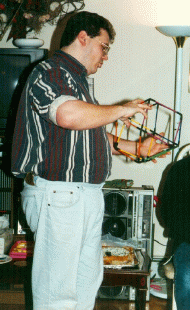 And this is a photo taken by my wife. It shows me demonstrating a toy called
the Vector Flexor which models Fuller's ``jitterbug.'' It's a cool toy --
and it amazes and impresses my friends.
And this is a photo taken by my wife. It shows me demonstrating a toy called
the Vector Flexor which models Fuller's ``jitterbug.'' It's a cool toy --
and it amazes and impresses my friends.
Copyleft © 1995 Christopher Rywalt.
crywalt@westnet.com
 This is a picture of a dome near Philadelphia. It appears to be used
to house antennae and satellite dishes.
This is a picture of a dome near Philadelphia. It appears to be used
to house antennae and satellite dishes.
 This is a picture of what is probably the most famous geodesic in the world,
namely the Geosphere at Walt Disney World, Florida. Disney's promotional
literature claims that this isn't a geodesic, because they say geodesics
are only partial spheres and this is a whole sphere. They're wrong:
being geodesic has nothing to do with how much of the sphere is present.
Actually, the name geodesic as applied to domes or spheres is something of a
misnomer, as modern geodesic designs only occasionally employ full great
circles.
In the next photo,
This is a picture of what is probably the most famous geodesic in the world,
namely the Geosphere at Walt Disney World, Florida. Disney's promotional
literature claims that this isn't a geodesic, because they say geodesics
are only partial spheres and this is a whole sphere. They're wrong:
being geodesic has nothing to do with how much of the sphere is present.
Actually, the name geodesic as applied to domes or spheres is something of a
misnomer, as modern geodesic designs only occasionally employ full great
circles.
In the next photo,
 which has the exploded polyhedron faces
delineated, you can see that the Geosphere is what's called a Class II
(or triacon) breakdown by Hugh Kenner in Geodesic Math. It's
a 16-frequency sphere. (Thanks to
George Hart for pointing me back to Geodesic Math to figure this out.)
That is, rather than subdividing the triangular faces of an icosahedron, as
you would in a Class I, you subdivide the rhombic faces of a rhombic
triacontahedron -- a thirty-sided solid.
which has the exploded polyhedron faces
delineated, you can see that the Geosphere is what's called a Class II
(or triacon) breakdown by Hugh Kenner in Geodesic Math. It's
a 16-frequency sphere. (Thanks to
George Hart for pointing me back to Geodesic Math to figure this out.)
That is, rather than subdividing the triangular faces of an icosahedron, as
you would in a Class I, you subdivide the rhombic faces of a rhombic
triacontahedron -- a thirty-sided solid.
 This is the Geosphere from another angle. (Looks
like a postcard, doesn't it? But it ain't -- I'm just a talented
photographer.)
This is the Geosphere from another angle. (Looks
like a postcard, doesn't it? But it ain't -- I'm just a talented
photographer.)
 This is a sculpture outside of the Smithsonian Institute in Washington, D.C.
It's not attributed or titled as far as I could find, but Jay Kappraff in
his very good book Connections attributes it to
Kenneth Snelson (not
too much of a surprise) and calls it Needle Tower. (Kappraff's book
also has a photo of it which is almost identical to mine.) And Joe Moore
helpfully writes: `` `Needle Tower' was designed by Kenneth Snelson in 1968
out of aluminum and stainless steel. It is 60' x 20'4" x 17'5". It is a
Tensegrity Tower. It was designed for and is installed in the Hirshhorn Museum
and Sculpture Garden, Smithsonian Institution, Washington, DC.''
This is a sculpture outside of the Smithsonian Institute in Washington, D.C.
It's not attributed or titled as far as I could find, but Jay Kappraff in
his very good book Connections attributes it to
Kenneth Snelson (not
too much of a surprise) and calls it Needle Tower. (Kappraff's book
also has a photo of it which is almost identical to mine.) And Joe Moore
helpfully writes: `` `Needle Tower' was designed by Kenneth Snelson in 1968
out of aluminum and stainless steel. It is 60' x 20'4" x 17'5". It is a
Tensegrity Tower. It was designed for and is installed in the Hirshhorn Museum
and Sculpture Garden, Smithsonian Institution, Washington, DC.''
 This is Needle Tower from underneath. In
fact, I got this shot quite by accident: I was looking for the sculpture's
attribution after having taken a picture from the side when I noticed a
patch of ground that had been worn grass-free underneath the structure.
Curious, I stood on that spot and looked up, and was rewarded with the view
you see here. Who says you should always take the road less travelled by?
This is Needle Tower from underneath. In
fact, I got this shot quite by accident: I was looking for the sculpture's
attribution after having taken a picture from the side when I noticed a
patch of ground that had been worn grass-free underneath the structure.
Curious, I stood on that spot and looked up, and was rewarded with the view
you see here. Who says you should always take the road less travelled by?
 And this is a photo taken by my wife. It shows me demonstrating a toy called
the Vector Flexor which models Fuller's ``jitterbug.'' It's a cool toy --
and it amazes and impresses my friends.
And this is a photo taken by my wife. It shows me demonstrating a toy called
the Vector Flexor which models Fuller's ``jitterbug.'' It's a cool toy --
and it amazes and impresses my friends.